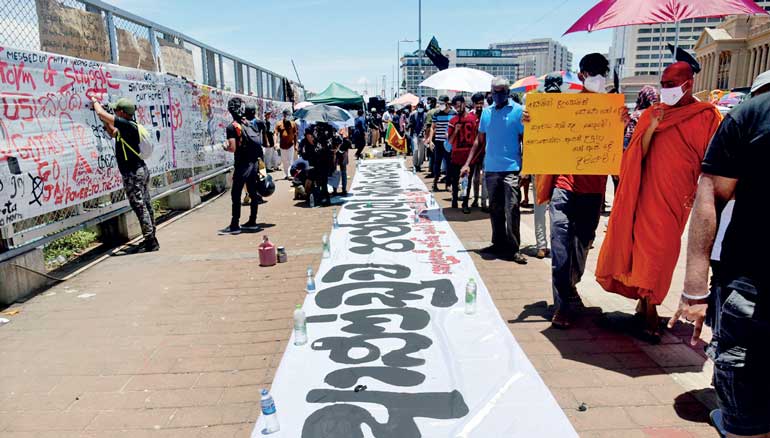Thursday Jan 01, 2026
Thursday Jan 01, 2026
Tuesday, 3 May 2022 00:11 - - {{hitsCtrl.values.hits}}

It’s not about how creative the Galle Face Green protests are; it’s all about why people are on a path of demanding economic, social and political freedom
At present, Sri Lanka is facing her biggest riddle after independence. The problem is clear, which is ‘forex crisis’, but the clarity is a grey area for some. The ‘some’ could only see the window itself, including the majority of MPs and local politicians, which could be very disastrous for the country in coming months. But if you look through the window warily, one could see the precession. The slow iteration, which begins in 1960s and accelerated after the liberalisation, including weak institutions, policy inconsistency and implementation gaps, corruption, inequality, and discrimination within layers of the society eventually led to fiscal imbalances of the country. 
The ruling family and their wolf pack, undoubtedly, had mismanaged the economy from the beginning of their term, starting with large tax cuts. Under the previous regime, the periodical IMF staff report for Article IV consultation and Extended Fund facility had clearly given the key priorities for further reformation of the economy, including strengthening institutions, SOE reforms, stability, inclusive growth and other priorities to promote fiscal consolidation, which was abended after the 2019 presidential election.
In 2022, Article IV consultation report reinstated similar types of stabilisation adjustments. In the light of going late to the IMF, the question evolved is, “Can Sri Lanka implement these recommendations?” The simple answer is “No”, which requires adopting an innovative approach. For instance, how could authorities liberalise certain areas while having a subsidy-oriented culture among societal groups. The objectives of the politicians and the culture of Sri Lankan society is well-connected. But today this culture is gradually changing, and this is why many Sri Lankan politicians are blanked with regard to their political future.
Political money cycle as a cultural bottleneck
The culture of politics in the developing world, including the one in Sri Lanka, integrated with inevitable societal values and norms which could affect the economic development process of a country. As of, political cost of fiscal austerity contends, in developing economies, governments face electoral costs, when they reduce budget deficits by cutting spending and raising taxes. When societal groups in Sri Lanka demand subsidies in terms of employment, money income, and other necessities for their livelihoods, the ones who could provide them will be popular among voters and will face no cost in an election. Eventually, the economic objectives will be overwritten by political objectives. Thus, relevant authorities would structure the public finances to increase the likelihood of re-election of incumbent governments. The most recent example is the “Weda Lashyak” program. It is a program which mismanages public finance, significantly. As of today, our people are experiencing the long-term consequences of this kind of mismanagement in the past.
The ideologies of the governments and their roles in economic development also played a critical part in this political money cycle. The UNP generally preferred the private sector led growth while SLFP-led coalitions favoured State ownership. State ownership ideology was somehow providing easy routes to address the subsidy oriented societal norms and values in the country. E.g., People considered a government job as a safety net, resulting in an unbearable 1.1 million public and semi government sector workers. Also, there were many incidents where market-led policies were rejected by some groups. Thus, public finance in this context was directed to gain the political popularity of the governments.
So the question that arises is once the country has very old people in top-seats, where should the change come from? Naturally, the theory of change would take place within societal groups. This is a result of long-term slow transformation in societal values and norms. One of the most influential factors for this cultural change is social mobility among the Sri Lankan population.
Social mobility
Social mobility simply refers to movements of social status in a society. The middle class is considered to be the most vital social strata for economic development. There is no universal definition for the middle class. Aristotle viewed the middle class as a group that held the greatest political power. Karl Marx believed the middle class consisted of individuals who were selfish and lacked ingenuity. But in the early nineties social parameters for the middle class held a more optimistic version signifying a group of high moral standards.
In the modern era, globally, the middle class has certain individualities, own houses, vehicles, asking for quality, and demanding other goods and services for comfortable lifestyles. These features were also visible in Sri Lanka and accelerated with the people who were high spenders to bring to the forefront of their social status. A dream wedding, buying a car, building one’s own place are among many other activities to safeguard their positions in the society, and these were quietly observable in both rural and urban economies.
Following colonialism, modernisation, and liberalisation over the past 10 decades in Sri Lanka, local society has led to changes in the structure of the social classes. In the post-economic liberalisation era, the shifts influenced the lifestyle of the rich, emerging middle class, and poor. Expansion of supermarket chains, motor vehicles, private education, healthcare, and other goods and services that dictate decent or luxury lifestyles of the people was increasingly evident. In addition, the accessibility and the purchasing power also have created social differentiation to some extent. Post-war era household income growth had driven the spending style of some groups in the society. In the post-war era, average household income at national level was increased by 110% showing a higher growth.
Other influencing factors of higher degree of social mobility during the past decade are ICT revolution in Sri Lanka, business climate, and growing demand for skills. Urban congestion in terms of commuting and residing are some indicators to outbox social mobility. On top of this, according to the Sri Lankan demographic structure, the share of the new-age population is rising. These facts would give us a clear indication of increasing changes of social norms, integrity, and values. These types of changes in the society could eventually lead to a social revolution, and it is a rare chance that could occur during a longer period of time, and it could change the course of the economic development.
Social revolution
A social revolution is vast and diverse. Individual behaviour is the key driver for these revolutions. At the moment the greatest revolution of the entire Sri Lankan history is happening here and there in the country. It’s not about how creative the Galle Face Green protests are; it’s all about why people are on a path of demanding economic, social and political freedom. The evidence suggests:
1) A revolution could occur when long-term socioeconomic development is followed by short-term sharp economic difficulties. The Sri Lankan population experienced gradual social development from the early nineties and accelerated during the post-war era. Now, specifically millennials of the middle-class strata had formed higher expectations as to what they believe they should continue to rise.
2) Despotism, corruption, lack of political freedom, and limitations in political participation were very well read by the middle class and urban dwellers in the country during the past two decades. Their perception was these facts were limiting the economic opportunities and reducing their standard of living.
3) In modernisation, specifically with social mobilisation, people were educated and urbanised, which led to higher political awareness. These groups are starting to request higher political participation. But Sri Lankan political institutions did not allow or established mechanisms to intersect the demand of these societal groups. There are 341 local level political institutions in Sri Lanka, which are accountable and responsible for good governance.
4) Considering the economic clusters in the country, youth have to migrate or even pay regular visits to the cities for their livelihood’s activities, may be in the form of professional or informal. Once they have integrated with this urban and suburban culture, information spillover is possible. Once they reach their homes, they could influence to change the attitudes of their families, which in turn could reflect the norms, integrity, and values of urban culture.
So, this revolution cannot be wrapped up as the Government is trying to, because these are conscious choices of the people and came within the societal groups. The only thing now our politicians can do is accept this change. #GoHomeGota2022, is not requesting the President to leave, it has a deeper meaning, advocating that this political and economic system required a change.
(The writer is working as a researcher and consultant. He is an Assistant Secretary of Sri Lanka Economic Association (SLEA). He has presented his own views and could be reached via email at [email protected].)